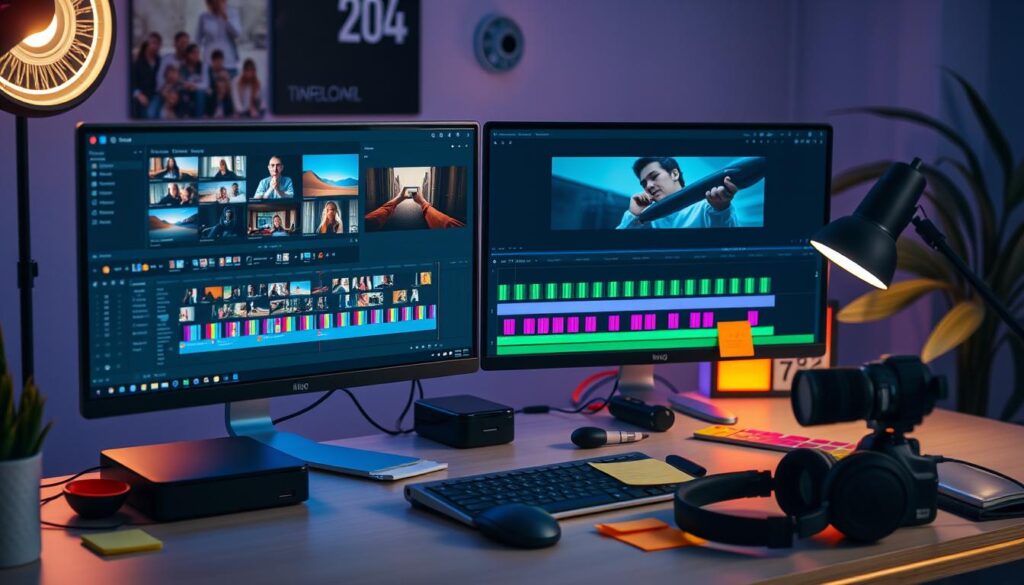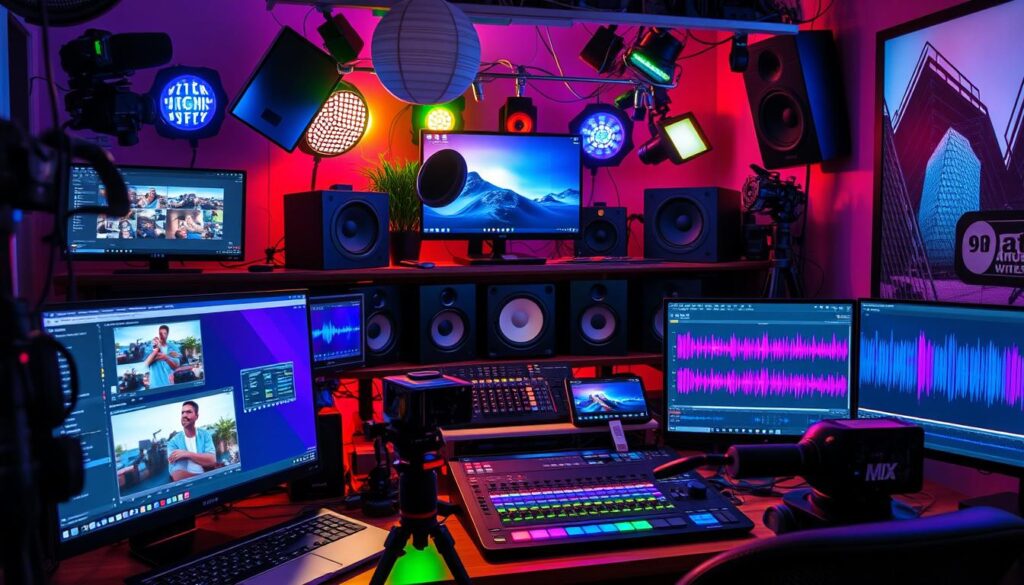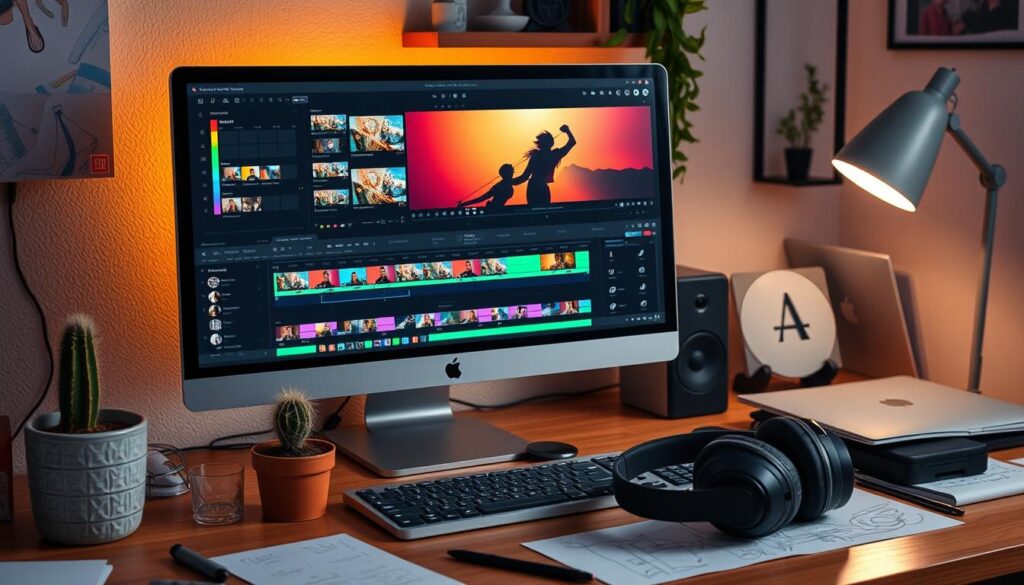Start your journey into video editing and unlock its power. This guide is perfect for anyone wanting to improve their video skills. You’ll learn from the basics to advanced techniques to make your videos stand out.
Key Takeaways
- Discover the core principles of video storytelling and how to effectively convey your message.
- Familiarize yourself with popular video editing software and their unique features.
- Learn essential video editing techniques, including cutting, trimming, and applying transitions and effects.
- Explore the video editing workflow, from organizing your project to exporting and sharing your final masterpiece.
- Develop your video editing skills through practical tips, online tutorials, and a wealth of resources.
Start this journey with confidence and let your creativity shine. This guide is for beginners and those looking to improve. You’ll learn how to make videos that impress. Get ready to unlock your video editing potential and take your content to new heights.
What is Video Editing?
Video editing turns raw footage into a polished story. It’s a tool for video editing for beginners to shape the story and control the pace. It’s about using video editing techniques to make a video impactful.
Understanding the Art of Storytelling
Good video editing is more than just cutting footage. It’s about creating a compelling story. Skilled video editing for beginners use techniques to guide the viewer. They create a sense of rhythm and emotion.
Elements of a Well-Edited Video
- Pacing: The rhythm and tempo of the video, which can be manipulated through clever editing to keep the viewer engaged.
- Transitions: The seamless flow between shots, which can set the tone and enhance the overall viewing experience.
- Emotion: The ability to evoke feelings and create a deeper connection with the audience through the careful selection and arrangement of footage.
- Visual Cohesion: The consistent style and aesthetic that ties the entire video together, creating a polished and professional look.
By learning these video editing basics, beginners can improve their skills. They can turn raw footage into engaging, story-driven videos.
“The best video editors are not just technicians; they’re artists who use their craft to tell stories and evoke emotions.”
Essential Video Editing Software
There are many video editing software options out there. Each one meets different needs and skill levels. Knowing the top video editing tools can boost your creativity and improve your video projects.
Adobe Premiere Pro is a leading desktop video editing software. It has many features like multi-track editing and advanced color grading. For beginners, Apple iMovie and Microsoft Video Editor are great. They have easy-to-use interfaces and simple workflows.
Mobile video editing apps also have a wide range. Adobe Premiere Rush and Apple iMovie for iOS are great for mobile use. Videoshop and KineMaster are also top choices for mobile creators. They offer tools for trimming, adding effects, and making videos on the go.
| Video Editing Software | Key Features | Platforms |
|---|---|---|
| Adobe Premiere Pro |
| Windows, macOS |
| Apple iMovie |
| macOS, iOS |
| Microsoft Video Editor |
| Windows |
| Adobe Premiere Rush |
| iOS, Android, Windows |
| Videoshop |
| iOS, Android |
| KineMaster |
| iOS, Android |
Choosing the right video editing software depends on your needs and skills. By looking into these popular tools, you can pick the one that suits your workflow and vision.
Video Editing Techniques
Learning to edit videos is key to making them engaging and polished. You can cut and trim footage, add cool transitions, and effects. These video editing techniques can take your videos to the next level.
Cutting and Trimming Footage
At the heart of video editing is cutting and trimming footage well. By picking the best clips, you shape your story and keep viewers interested. Check out video editing tutorials to improve your cutting skills.
Adding Transitions and Effects
Smooth transitions and cool effects can make your video look pro. Look into video editing techniques for adding transitions and effects. Try different ones to find what works best for your video.
Remember, the secret to getting good at video editing tips is to keep practicing. By using these basic techniques, you’ll make videos that grab and hold your audience’s attention.
Video Editing Workflow
Starting a video editing project can feel overwhelming. But, a good video editing workflow can change everything. It helps you organize your files and manage your project well. This makes editing faster and improves your video editing skills.
Organizing and Managing Your Project
A solid video editing workflow starts with good organization. First, set up a clear file structure. Put your footage, audio, and other assets in organized folders. This makes it easy to find what you need.
Then, create a naming system for your files. This helps you keep track of different versions of your video. Use the same labels for clips, project files, and final videos.
- Organize your media files into logical folders
- Establish a clear naming convention for your files
- Use markers, notes, and metadata to keep track of your editing progress
When you start editing, use your video editing software‘s tools. Markers, notes, and metadata help you stay organized. This makes your workflow smooth and efficient.
| Tips for Organizing Your Video Editing Project | Benefits |
|---|---|
| Create a consistent file structure | Easily locate and access media files |
| Implement a clear naming convention | Identify different versions and project elements |
| Use markers, notes, and metadata | Keep track of editing progress and decisions |
Focus on organizing and managing your project. This will make your video editing workflow better. You’ll also find more video editing tips for your next projects.

Video Editing for Beginners
Are you ready to start your video editing journey? Video editing for beginners opens up a world of creativity. It lets you turn raw footage into engaging stories. Learning the basics is key to making your videos look professional.
First, you need to know the basics of video editing skills. Editing means picking, arranging, and perfecting each clip. By mastering cuts, trims, and transitions, you can make your videos come alive.
- Get to know your video editing software. Learn all the tools and features to help you bring your vision to life.
- Focus on storytelling. Think about how each shot affects the story’s mood and flow.
- Try out different editing styles. Experiment with cuts, pacing, and effects to find what works best for you.
- Keep practicing. The more you edit, the better you’ll get.
Video editing for beginners is all about exploring and learning. Be patient and let your creativity flow. With hard work and a desire to learn, you’ll make videos that engage and inspire people.
“Editing is not simply the assembly of shots, but the shaping of a film’s narrative and emotional impact.”
| Essential Video Editing Skills | Description |
|---|---|
| Cutting and Trimming | Precisely selecting and refining footage to maintain the flow and pacing of your video. |
| Adding Transitions | Seamlessly connecting clips to create a smooth and professional-looking video. |
| Incorporating Effects | Enhancing your video with visual elements that add depth, mood, and visual interest. |
Enhancing Audio in Your Videos
Creating engaging videos is more than just great visuals. Audio is key to a better viewing experience. We’ll look at video editing techniques and video editing tips to boost your audio.
Using a good microphone is essential. Get a reliable one and try different recording methods for clear sound. Proper placement, adjusting levels, and reducing background noise are important.
- Use a dedicated microphone for narration or interviews
- Place the microphone right to avoid unwanted sounds
- Check and adjust audio levels for the best sound
Choosing the right background music can also enhance your videos. Pick tracks that match your video’s mood and pace. Play with volume and mixing to get the perfect mix.
“The right background music can elevate your video from good to great.”
Don’t forget about audio effects to add depth. Adjusting pitch, adding reverb, or using sound effects can make your video more engaging. Learning these video editing techniques will help you perfect your audio.

Improving your audio can turn your videos into something special. Use these video editing tips to make your audio stand out.
Color Correction and Grading
Color correction and grading are key in making videos stand out. These video editing techniques can change how your footage looks. They make your video more cinematic and appealing.
Achieving a Consistent Look
Consistency is important in color grading. A unified color scheme makes your video look professional and cohesive. It also improves the mood and tone of your story.
To get a consistent look, follow these video editing tips:
- Choose a color theme or style, like a moody or vibrant look.
- Adjust brightness, contrast, and saturation to match your theme.
- Use color grading presets or create custom LUTs for a consistent look.
- Check the color balance and white balance to keep things harmonious.
Mastering these video editing techniques can make your videos more engaging. It will captivate your audience with a visually stunning final product.
“Color grading is the final step in the video editing process that can truly make or break the overall look and feel of your production.”
Use the many video editing tools to try out color correction and grading. Don’t hesitate to experiment with different techniques to find the perfect look for your video.
Exporting and Sharing Your Videos
As you near the end of your video editing workflow, it’s time to export and share your video. Choosing the right file format and resolution is key. This ensures your video looks great on different platforms and devices.
Think about where you’ll share your video and the video editing skills needed. Each platform has its own preferences for codecs, resolution, and file size. Knowing these helps you make your video easy to watch.
Exporting for the Web
For online sharing on sites like YouTube, Facebook, or Vimeo, MP4, MOV, or WebM are top choices. These formats balance quality and file size well. This means your video will load fast and play smoothly.
Exporting for Offline Viewing
For offline sharing, like on a DVD or USB drive, you might need different formats and resolutions. AVI or MKV files are good for personal use or local screenings. They keep high visual quality without streaming limits.
Experiment with video editing tips and export settings to find the best quality and size. This way, everyone can enjoy your video, whether on a phone or a big screen.
Creating a great video is more than just editing. Good exporting and sharing strategies can make your work more visible. By honing these video editing skills, you’ll share your stories with the world.
Video Editing Tools and Resources
Starting your video editing journey? The right tools and resources are key. You’ll find everything from top-notch software to online tutorials and communities. Let’s dive into what you need to boost your skills.
Recommended Software and Apps
There’s a lot of video editing software and apps out there. Each has its own special features. Here are some top picks:
- Adobe Premiere Pro: A top choice for professional video editing.
- Final Cut Pro: Great for Mac users, known for its ease of use.
- DaVinci Resolve: Free and powerful, perfect for all levels.
- iMovie: Ideal for making simple videos on Apple devices.
- Filmora: Affordable and easy to use, with lots of creative tools.
Online Tutorials and Communities
There’s more to video editing than just software. Online resources are full of tutorials and tips. Here’s where to find them:
- YouTube tutorials: Loads of educational videos on editing techniques.
- Online courses: Udemy, Skillshare, and Coursera have great video editing courses.
- Reddit communities: r/VideoEditing and r/VideoEditingTips are great places to connect with others.
- Creative blogs and forums: Sites like PremiumBeat and Video Maker Pro offer lots of helpful articles and discussions.
With the right tools, software, and online resources, you’ll get better at video editing. Keep exploring, trying new apps, and joining communities. This will help you grow and make amazing videos.
Building Your Video Editing Skills
Starting your video editing journey means always getting better. It’s about practicing, trying new things, and learning from experts. With a growth mindset, you can reach new levels in video editing.
Improving your video editing skills starts with practice. Set aside time each day or week to work on your projects. Try out different video editing techniques and see what your software can do. The more you do it, the better you’ll get.
It’s also important to find new video editing tips and techniques. Look for online tutorials, workshops, or find a mentor. Join the video editing community to learn from others, ask questions, and get feedback on your work.
- Embrace a growth mindset and continuously seek opportunities to learn and improve
- Dedicate regular time to practicing your video editing skills and experimenting with new techniques
- Engage with the video editing community to learn from experienced professionals and receive constructive feedback
Mastering video editing is a journey that never ends. The more you work on your skills, the more fun and rewarding it will be. Keep going, celebrate your successes, and let your love for storytelling lead the way.
Conclusion
Starting your video editing journey is exciting. You’ve learned a lot so far. But remember, video editing keeps getting better, and you’ll find new ways to express yourself.
Whether you’re new or experienced, always keep learning. Be curious and try new things. Use your skills to make videos that grab people’s attention.
The journey to becoming a great video editor is more than just using software. It’s about paying attention to details, rhythm, and connecting with your audience. By using what you’ve learned, you’re on your way to becoming a skilled video editor.



